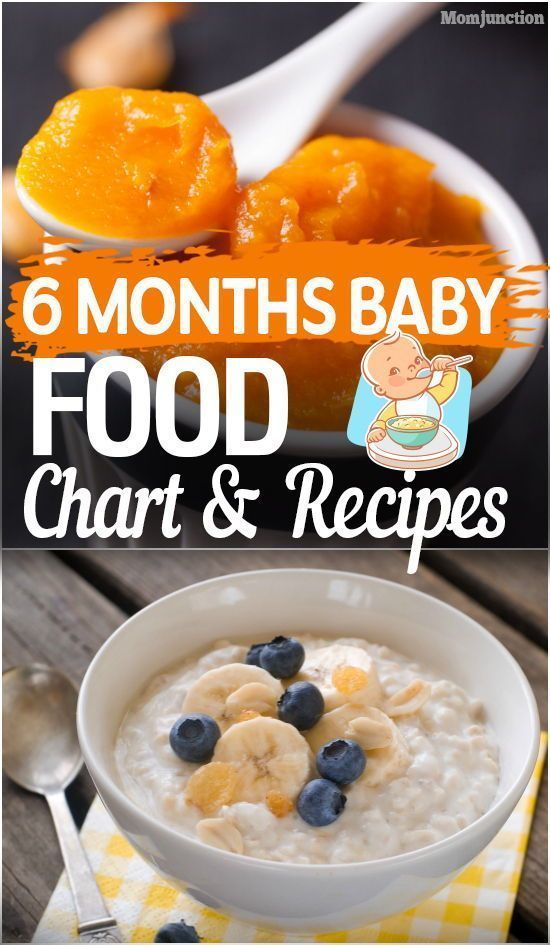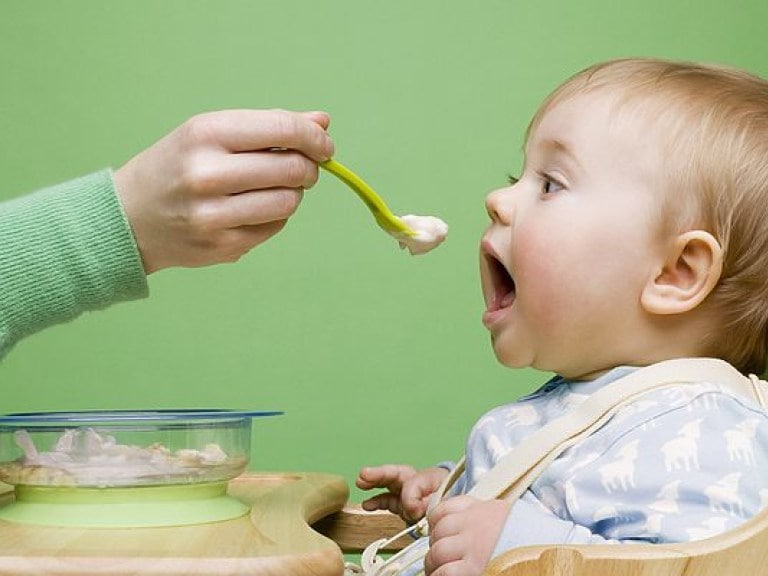10 months baby food recipes video
10 Months Old Baby Food Chart
Congratulations! Your baby is 10-months-old now, and you must be so proud that you have taken care of your little munchkin so well. You must have noticed a lot of changes in him – he must be crawling, communicating, or even playing. But like every responsible parent out there, you must be worried about his nutritional requirements and overall health. If you are looking for food suggestions for your child, we have something for you. Here we will discuss what you should feed to your 10-month-old baby.
Video: Food Ideas for a 10-Month-Old Baby
Nutrient Requirements of a Baby at This Age
The calorie requirements of a baby at this age depends entirely on his weight. As a general rule of thumb, your 10-month-old baby will need anywhere between 90 and 120 calories per kilogram of his weight. According to the experts, this translates to 793 calories for male babies and 717 calories for female babies. Your baby will need food from the main food groups. You can follow the basic food pyramid chart in order to understand the ratio of fruits, vegetables, and grains that you need to follow while serving food to your child. Apart from this, you will have to make sure that your baby gets an adequate amount of calcium and iron in his diet. This is essential for his physical and mental development.
How Much Food Can Your Baby Eat in a Day?
The amount of food consumed regularly will be dictated by your baby’s nutritional requirements and appetite. However, as a general rule of thumb, your baby will need different food items in the following quantities.
- Cereal – between ¼ and ½ cup
- Fruits – between ¼ and ½ cup
- Vegetables – between ¼ and ½ cup
- Dairy products – 2 to 3 tablespoons
- Protein or meat – 4 tablespoons
Best Foods for Your Ten-month-old Baby
An important thing you should remember while giving food to your 10-month-old baby is that you can start supplementing breast milk with regular foods. You can give him finger food or mashed food instead of breastfeeding him. However, there is no hard and fast rule as to when you must stop breastfeeding entirely. This is a decision that you should take after consulting your doctor. If you do decide to wean your baby, there are some foods that should be your top choice.
You can give him finger food or mashed food instead of breastfeeding him. However, there is no hard and fast rule as to when you must stop breastfeeding entirely. This is a decision that you should take after consulting your doctor. If you do decide to wean your baby, there are some foods that should be your top choice.
- Whole wheat idli or dosa
- Moong dal khichdi
- Upma with vegetables
- Dalia
- Homemade milkshake with fresh fruits
- Boiled or scrambled eggs
- Vegetable soup
- Homemade halwa
- Mildly spiced sambar
Video: Diet Plan for 10 Month Old Baby
A Sample Food Chart/Meal Plan for a 10-month-old Baby
Here is a sample chart that you can follow for making a healthy meal plan for your ten-month-old baby.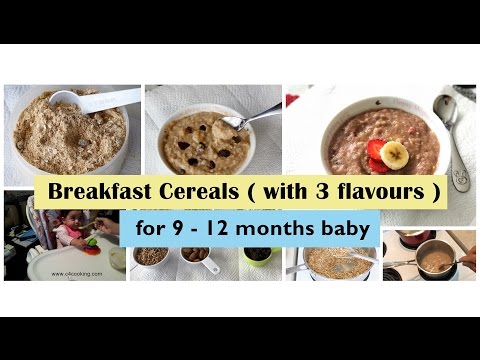 However, it is recommended that you introduce each new food item one at a time. Wait for three days before you introduce another food item as it is the perfect window to observe if your baby has any allergies. This will also let him get used to the flavour. You can make some changes in this plan and create a meal plan that suits your 10-month-old baby.
However, it is recommended that you introduce each new food item one at a time. Wait for three days before you introduce another food item as it is the perfect window to observe if your baby has any allergies. This will also let him get used to the flavour. You can make some changes in this plan and create a meal plan that suits your 10-month-old baby.
Diet for a 10 Month-Old – Week 1, Day 1
Diet for a 10 Month-Old – Week 1, Day 2
| Early morning | Mother’s milk /formula feed |
| Breakfast | Oats-apple smoothie |
| Mid-morning | Mashed banana |
| Lunch | Bajra (pearl millet)- moong dal (green gram split) khichdi |
| Evening | Mother’s milk /formula feed |
| Dinner |
Diet for a 10 Month-Old – Week 1, Day 3
Diet for a 10 Month-Old – Week 1, Day 4
Diet for a 10 Month-Old – Week 1, Day 5
Diet for a 10 Month-Old – Week 1, Day 6
Diet for a 10 Month-Old – Week 1, Day 7
Diet for a 10 Month-Old – Week 2, Day 1
Diet for a 10 Month-Old – Week 2, Day 2
Diet for a 10 Month-Old – Week 2, Day 3
Diet for a 10 Month-Old – Week 2, Day 4
Diet for a 10 Month-Old – Week 2, Day 5
Diet for a 10 Month-Old – Week 2, Day 6
Diet for a 10 Month-Old – Week 2, Day 7
Diet for a 10 Month-Old – Week 3, Day 1
Diet for a 10 Month-Old – Week 3, Day 2
Diet for a 10 Month-Old – Week 3, Day 3
Diet for a 10 Month-Old – Week 3, Day 4
Diet for a 10 Month-Old – Week 3, Day 5
Diet for a 10 Month-Old – Week 3, Day 6
Diet for a 10 Month-Old – Week 3, Day 7
Diet for a 10 Month-Old – Week 4, Day 1
Diet for a 10 Month-Old – Week 4, Day 2
Diet for a 10 Month-Old – Week 4, Day 3
Diet for a 10 Month-Old – Week 4, Day 4
| Early morning | Mother’s milk /formula feed |
| Breakfast | |
| Mid-morning | Mashed chikoo (sapota) or mashed banana |
| Lunch | |
| Evening | Mother’s milk /formula feed |
| Dinner |
Diet for a 10 Month-Old – Week 4, Day 5
Diet for a 10 Month-Old – Week 4, Day 6
| Early morning | Mother’s milk /formula feed |
| Breakfast | |
| Mid-morning | Mashed papaya |
| Lunch | Tomato- pumpkin soup |
| Evening | Mother’s milk /formula feed |
| Dinner |
Diet for a 10 Month-Old – Week 4, Day 7
Video: Food Recipes for a 10-month-old Baby
Tasty Recipes That You Can Try
Given below are the recipes to some healthy food items that you can make for your 10-month-old baby in no time. These recipes are nutritious and will ensure your baby’s all-round development.
1. Semolina Upma
Ingredients
- Semolina/suji – ½ cup
- Mixed veggies like carrots, peas, beans, and boiled potatoes – ½ cup diced
- Jeera – 1 cup
- Water – ¼ tsp
- A pinch of turmeric
- A pinch of salt
- Oil or ghee – ¼ tsp
How to Prepare
- Roast the suji in a pan until it gives a toasty aroma. Keep stirring continuously as it burns quickly otherwise. Keep aside in a bowl.
- In a pan, heat the oil or ghee.

- Add in the jeera and wait until they turn brown.
- Add in the veggies then turmeric and salt. Sauté for about 5 minutes. Add in the semolina and mix it well.
- Next, add in the water and stir continuously to make sure no lumps are formed.
- Stir until the desired consistency is reached.
2. Plain Khichdi
Ingredients
- Toor dal – ¼ cup
- Rice – ¼ cup
- Water – 2 ½ cups
- Tomato – 1, diced
- Oil or ghee – ¼ tsp
- Jeera – ¼ tsp
- A pinch of asafoetida
- Ginger – ¼ inch
- Salt to taste
How to Prepare
- Wash and clean the dal and rice separately until the water runs clear. Soak the rice and dal separately in water for about 30 minutes.
- Strain the water and pressure cook the dal and rice together for up to three whistles. Add in the turmeric also.
- Since you will be making it for your child, add in more water to make it soft.
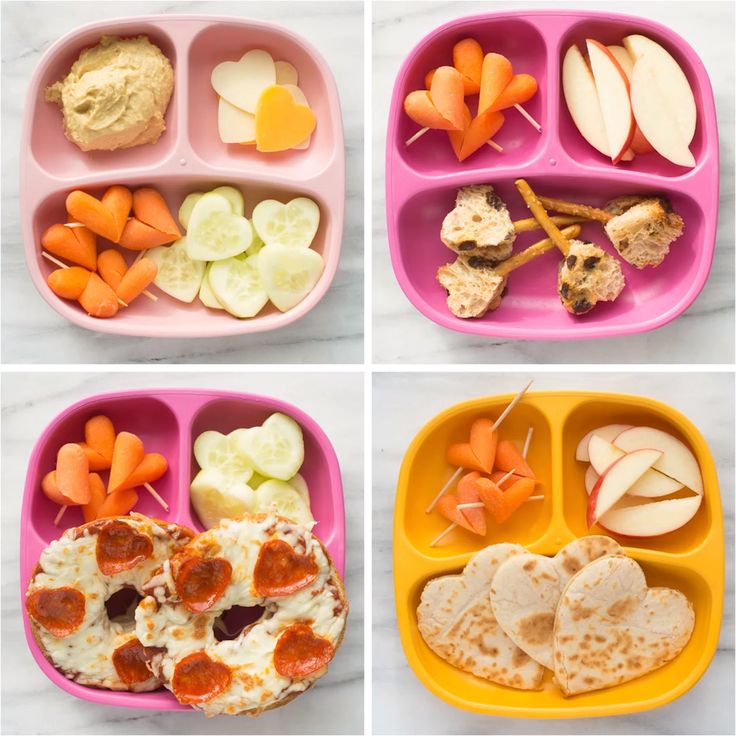
- Heat the oil or ghee in a pan. Add some cumin seeds and wait till their colour changes.
- Add in the asafoetida, ginger, and tomato and sauté for a few minutes.
- Add in the cooked rice and dal mixture and give it a nice stir.
- Add some salt and let the khichdi boil for a few minutes. It should be a little watery.
3. Scrambled Eggs
Ingredients
- Egg – 1
- Whole milk/formula/breast milk – 2-3 tablespoons
- Fresh cheddar cheese or any other fresh cheese (grated) – 1 tbsp
- Refined oil – 1 tsp
- Salt to taste
- Pepper to taste
How to Prepare
- Crack open the egg into a bowl then add the milk and whisk for a couple of minutes.
- Add in the grated cheese and mix well.
- Heat the oil in a pan. Pour the whisked egg mixture into the pan and stir continuously until the eggs are fully cooked.
- Add the salt and mix well.
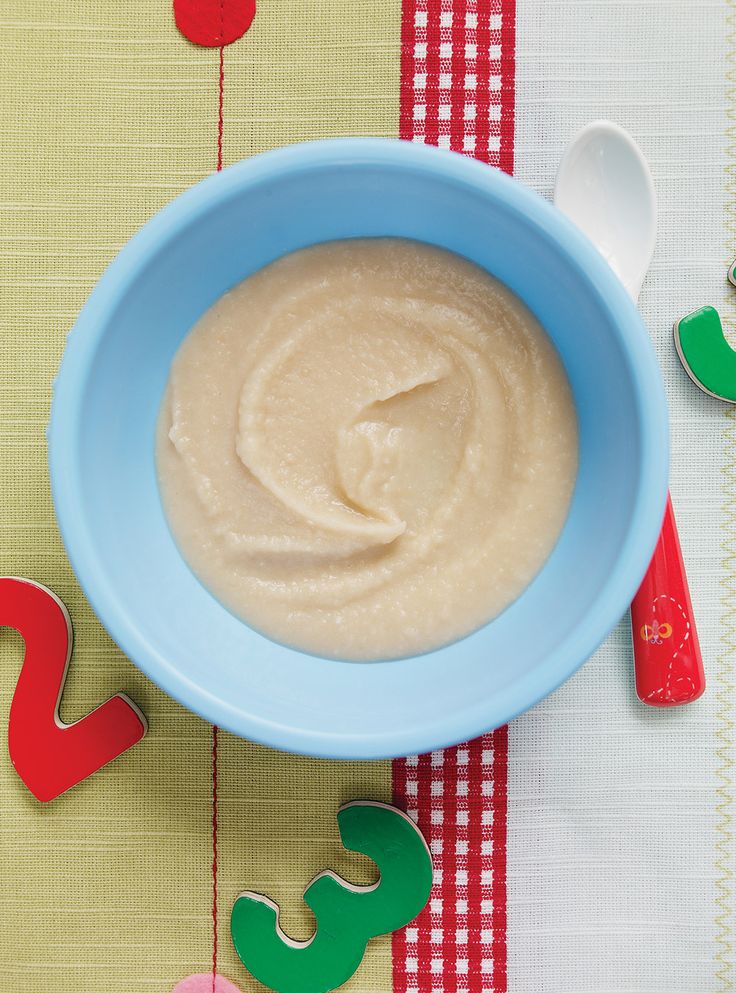 Serve warm!
Serve warm! - You can also add some finely cut vegetables to get your child to like veggies.
4. Chicken and Potato Soup
Ingredients
- Potatoes (peeled and diced) ½ cup
- Diced chicken – ½ cup
- Diced onion – ½ cup diced
- Freshly grated cheddar cheese – ½ cup
- Garlic cloves – 2
- Butter – 2 tbsp
- Water – 2 cups
- Salt to taste
- Pepper to taste
How to Prepare
- In a large pot, heat the butter.
- Add in the onions and cook them until they turn transparent. Add the garlic and sauté for a couple of minutes.
- Add in the potatoes and cook them for some time.
- Next, add the water and bring to a boil. Add the cheese bit by bit while continuously stirring.
- Bring to a boil once again and add the diced chicken. Cover the pot with a lid and let it cook for 10 minutes until the chicken is fully cooked.

- Season with salt and pepper and the soup is ready.
- If you have cut the potatoes and chicken small enough, let your baby eat them.
- However, if you think your baby is finding it difficult, Blend the soup then give it to your baby.
5. Broken Wheat Porridge
Ingredients
- Broken wheat – ¼ cup
- Water – 1 cup
- Roasted almond powder 1 tsp
- Apple or banana puree – 1 cup
How to prepare:
- Pressure cook the broken wheat and water for three whistles. Allow it to cool.
- Next, transfer it to a blender and blend to get a smooth consistency.
- Transfer it to a bowl then add the almond powder and mix.
- Add the banana or apple puree for sweetness.
Some Tips to Consider
Here are some tips that you should follow before and while feeding your little one.
- Sterilize the utensils you use for your baby.

- Taste the food you prepare for your little one before giving it to him. Make sure it is neither too hot nor too cold. The food should be warm.
- Don’t add too much salt. To enhance the flavour of any dish, add in the cheese!
- Be sure to adjust the ingredients according to your baby’s preferences and nutritional requirements.
- Introduce only one solid food at a time. Wait for three days before introducing any other food. This way you will help your child develop a taste for that particular food. You should also look for any symptoms of allergy in three-days time after having introduced the new food.
- Consult your paediatrician before introducing any new food.
Feeding a 10-month-old is a period of experimentation. As your baby begins to distinguish between flavours and starts to have favourites, you will be able to develop meal plans that your baby truly enjoys. Keep the food pyramid in mind when planning meals and be sure to consult with your paediatrician on what you can and cannot feed your baby.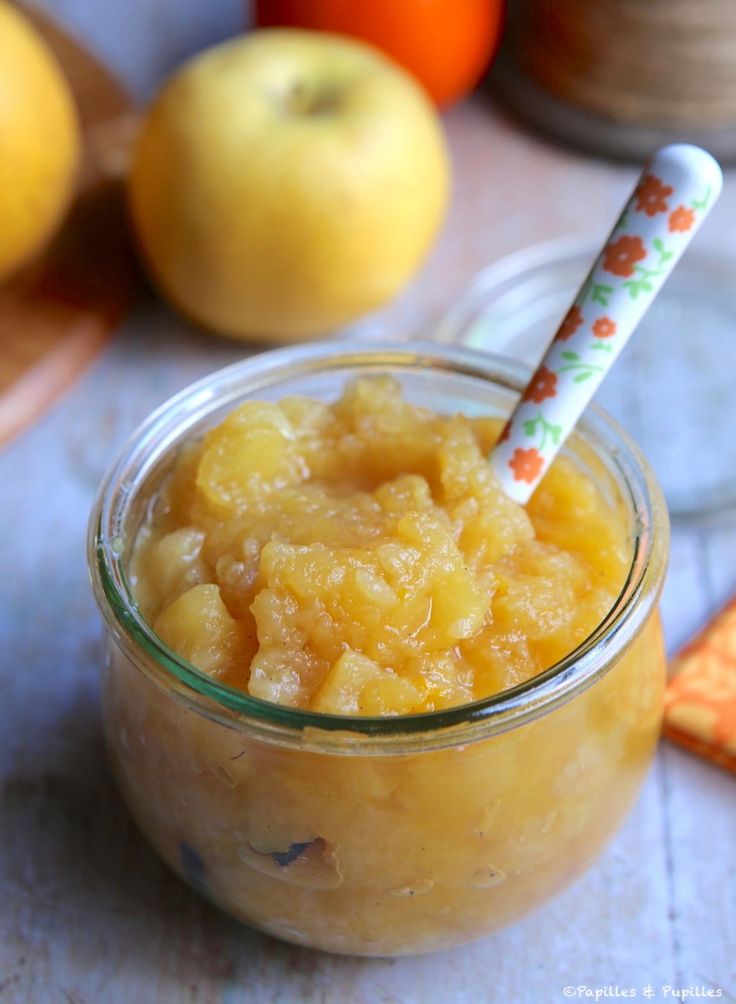
Disclaimer:
- Each child is different and so use these meal plans as a trusted guide as per your discretion. You can modify the meals according to your child’s preferences / requirements.
- Never force-feed a child.
- While preparing formula, please follow the instructions on the box and use the measuring spoon provided with it.
- While introducing solid food to a baby, initially, one needs to prepare watery gruels/soups. As a child gets older, the caretaker/ mother has to increase the thickness of the liquids slowly according to the child’s capacity to swallow. Foods that are too thick can cause stomach upset/ unnecessary load; while excessively watery food might cause the child to remain hungry.
- Some kids may eat less on some days and that is absolutely alright. However, if a child eats less for more than 3-4 consecutive days, please visit a doctor to guide further.
- A child may eat less during the teething phase or if he/she may not be feeling well.
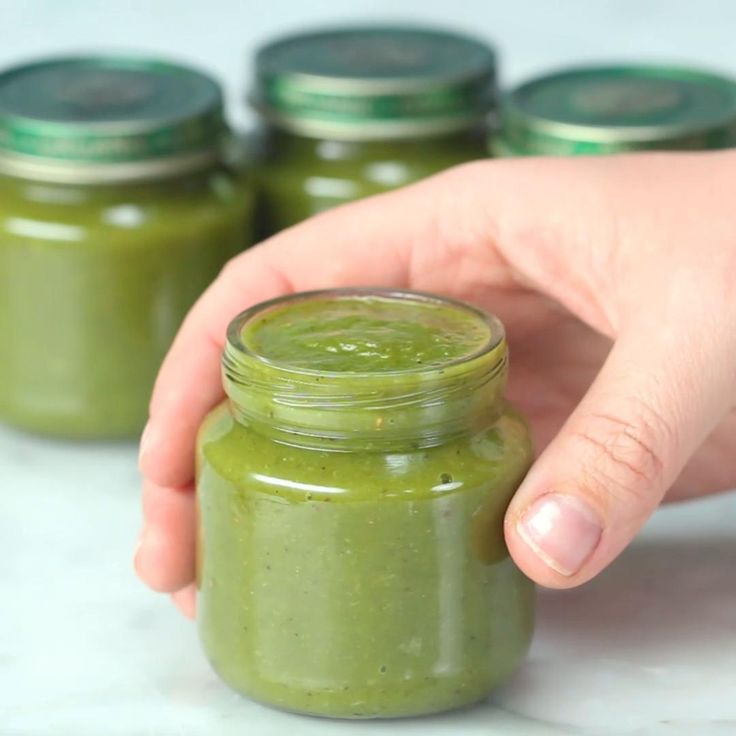 You could increase breast milk /formula feeds on those days. Re-introduce the foods once the child is back to normal.
You could increase breast milk /formula feeds on those days. Re-introduce the foods once the child is back to normal. - Don’t stop feeding if the child is suffering from diarrhoea.
- You can alter the taste of the food by adding some natural flavours like cinnamon, jeera powder, lemon juice, curry leaves etc. if the child doesn’t accept the food initially.
- If your child suffers from an allergy to nuts, gluten or eggs, please consult your doctor before feeding him/her any foods that may contain them.
Also Read: Food Ideas for 13 to 16 Months Old Baby
15 Stage One Baby Food Purees (4-6 Months)
Home » Feeding Style » Baby Food Purees » Stage One » 15 Stage One Baby Food Purees
These 15 Stage One Baby Food Recipes will tempt your baby’s taste buds! These simple, homemade baby food recipes are made with nutrient-dense fruits and vegetables with an added pinch of spice that makes these purees out-of-this-world delicious! They’re great for babies 4-6+ months of age!
Medically reviewed and co-written by Jamie Johnson, Registered Dietitian Nutritionist (RDN), and Lauren Braaten, Pediatric Occupational Therapist (OT).
Are you looking to make your baby homemade purees, but don’t know where to start? Does the process intimidate you?
Then you have come to the right place! Here you will find 15 of my all-time favorite starter baby food purees that have been viewed (and made) millions of times by my readers and combined have over 400 5-star reviews!
I would also like to personally welcome you to the wonderful world of baby food, this is a fun (and yummy) club to be in.
Does your baby’s first bite need to be boring?
Of course not!
Baby’s food can (and should be) delicious from the very start!
While it may seem daunting at first, making your own baby food is super easy once you get the hang of it.
And I’m here to walk you through it every step of the way.
First time making homemade baby food? Then I suggest you start this journey by reading my in-depth Guide on How to Make Homemade Baby Food.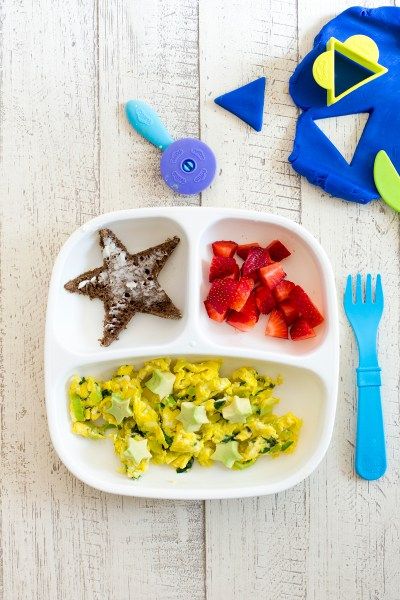 The detailed guide goes over all the important information such as the best cooking tools to have on hand, safe storage, how to know when baby is ready for solids, how to introduce purees, the best first foods for baby, and so much more! You can also check out my best-selling cookbook for even more information and recipes!
The detailed guide goes over all the important information such as the best cooking tools to have on hand, safe storage, how to know when baby is ready for solids, how to introduce purees, the best first foods for baby, and so much more! You can also check out my best-selling cookbook for even more information and recipes!
15 Stage One Baby Puree Video
While the recipes themselves are simple, in this video I will show you how to add in a pinch of cinnamon, rosemary, curry, or mint to quickly roasted or steamed fruits and vegetables that enhance their natural flavors. In other words, these are simple purees that I am pretty sure you will want to eat as well!
What is In Each Puree Recipe
After going through this guide, you will want to check out some (or all!) of the homemade baby food recipes below. Each recipe goes into detail about the:
- produce that is in the puree
- benefits of that produce for your baby
- recipe cooking options
- detailed photos and videos with step-by-step instructions
Reminder: The homemade baby food recipes below are made for babies that want to try the most delicious food from the very first bite! 😋
Helpful ToolsLet’s start with a few of my favorite kitchen essentials to make the best homemade baby food purees! These kitchen tools will help make the process of cooking, blending, and freezing baby food hassle-free.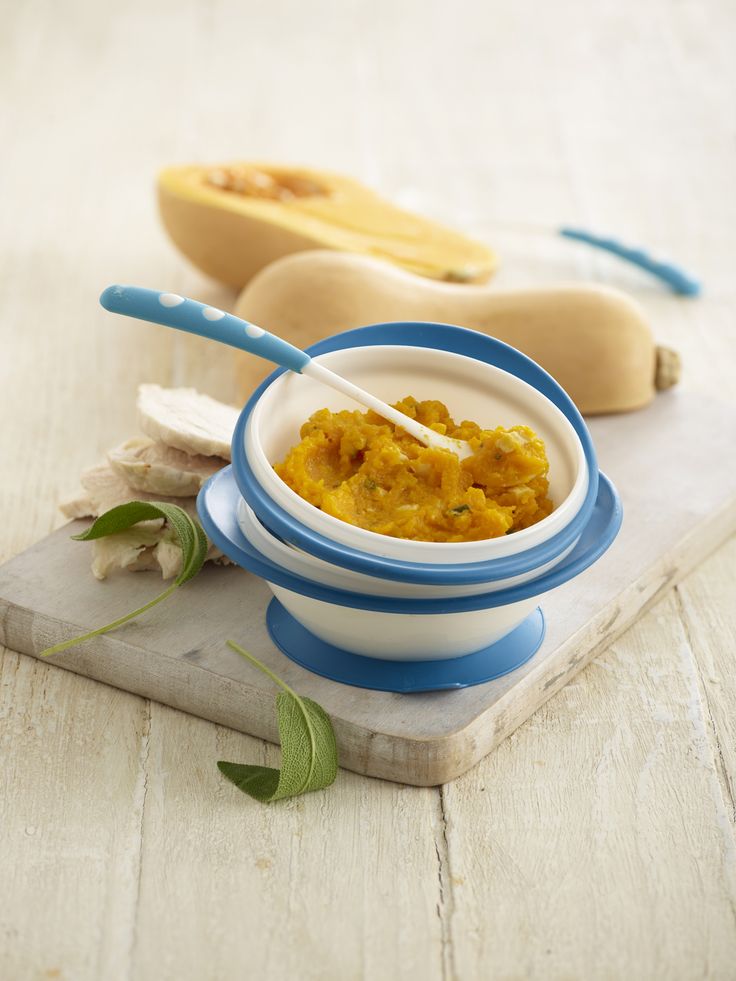 You can find a full list of my favorite baby and toddler food making tools in my online Shop.
You can find a full list of my favorite baby and toddler food making tools in my online Shop.
- Blender or Food Processor
- Freezer Storage Tray
- Fridge Storage Containers
- Stasher Bag
- Baking Sheet
- Steamer Basket
- Medium Saucepan
- Reusable Pouches
- High Chair
- Suction Bowl and Spoon Set
- Bib with Food Catcher
Learning Resources: looking for the best high chair, cups or spoons for your baby? Then we’ve got you covered! Here you will find How to Find the Best High Chair for Baby, an easy guide on Best First Open Cups for Baby (plus 4 tips when introducing a cup) as well as 3 Tips on How To Spoon Feed Baby (plus – our favorite spoons for purees or BLW).
Frequently Asked QuestionsCan babies have spices in their food?
Yes, yes, yes! Babies can absolutely have spices mixed into their purees from the very first bite.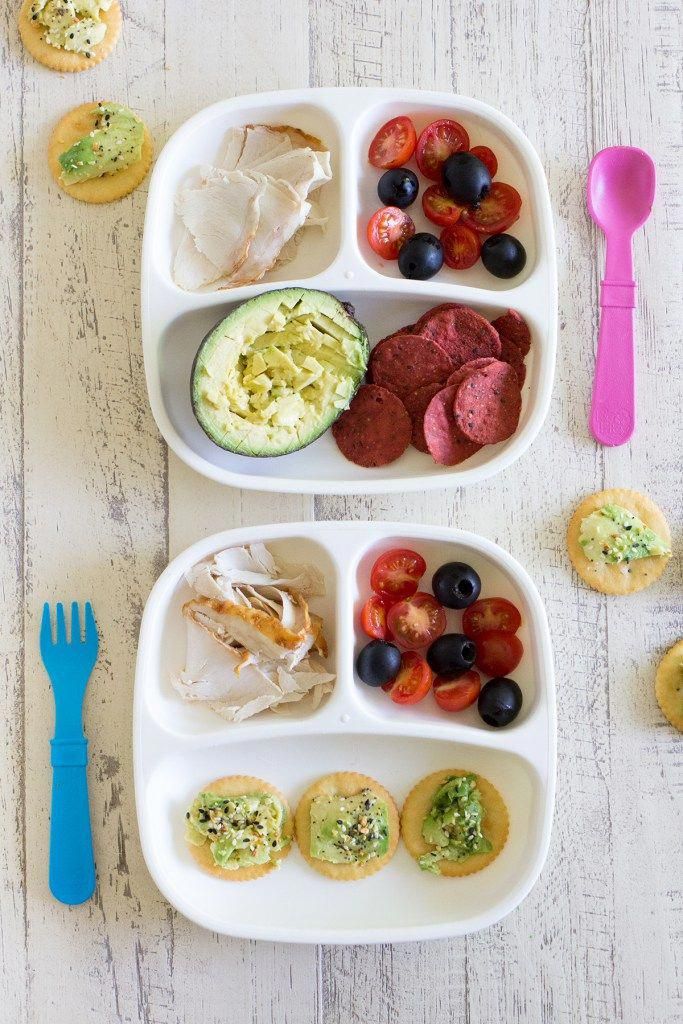 Adding a pinch of spice or herbs to a baby’s food makes it taste better and gives the food additional medicinal properties. Read more here. But as I always say — you do you! If you don’t want to add spices to your baby’s food, you can certainly leave them out. Don’t worry, I give instructions on each recipe card for both.
Adding a pinch of spice or herbs to a baby’s food makes it taste better and gives the food additional medicinal properties. Read more here. But as I always say — you do you! If you don’t want to add spices to your baby’s food, you can certainly leave them out. Don’t worry, I give instructions on each recipe card for both.
What about allergies? Can spices cause an allergic reaction?
My rule of thumb is that unless there is an immediate family member that has a true allergy to a certain spice or food, then introducing your baby to spices at the same time as new food is completely acceptable. Spice and herb allergies in babies and adults are very rare. But remember, it’s always recommended to keep an eye on your baby when introducing any new food or spices.
At what age should I start my baby on baby food purees?
When a baby can start on solid foods is determined by their own rate of development, which generally comes between 4-6 months of age. Some of the developmental milestones babies need to reach to start solids include: if your baby has solid control of their head and neck, if your baby has doubled in weight, and if your baby is reaching for or opening their mouth when you eat (see my guide here). Before you start your baby on purees, you should consult with your pediatrician to make sure your child is developmentally ready for solids.
Some of the developmental milestones babies need to reach to start solids include: if your baby has solid control of their head and neck, if your baby has doubled in weight, and if your baby is reaching for or opening their mouth when you eat (see my guide here). Before you start your baby on purees, you should consult with your pediatrician to make sure your child is developmentally ready for solids.
All of our baby food recipes are designed to enhance the natural taste of the fruits and veggies while keeping as many nutrients intact as possible. In other words, the goal is to make a puree that’s both healthy and delectable.
There are several ways you can cook baby food purees, but the main techniques I use are:
- Steaming
- Roasting
- Simmering
- Raw
Keep in mind, that as long as the produce is cooked until soft, that there isn’t a right or wrong way to cook it for baby food.:strip_icc():format(jpeg)/kly-media-production/medias/2715426/original/084314100_1548738668-adorable-baby-baker-35666.jpg)
If a recipe for broccoli calls for steaming but you want to roast it because you will already be roasting some broccoli for yourself for dinner, then go ahead and roast the broccoli for your baby’s puree. Play around and have some fun with it!
Adding Spices to Baby PureesIt’s encouraged that you can serve your baby a homemade puree with a pinch of spices or herbs from the very first bite.
Benefits of Spices
- boost and compliment any fruit or vegetable puree
- broaden baby’s emerging palate
- add more flavor and depth into their foods
- decrease picky eating in the years to come
- have medicinal properties in them — they can help with digestive issues, boost brain functions, repair muscle tissues, and so on.
While each puree recipe on this site has a selection of spices or herbs that complement the flavors of the fruit or vegetable in the puree, it’s up to you if you want to add them. You do you! Either way, the puree recipes on this site will be delicious.
You do you! Either way, the puree recipes on this site will be delicious.
Top Spices to Add to Baby’s Puree
- Cinnamon
- Cloves
- Nutmeg
- Basil
- Mint
- Parsley
- Mild Curry Powder
- Fresh Lemon Juice
- Garlic
- Rosemary
Every recipe below has specific instructions on how to store that particular puree, but these are the general guidelines.
How to Freeze Baby FoodYour freezer is about to become your new best friend, allowing you to keep several weeks’ worth of baby purees at the ready. Whenever you make a puree, put several ounces in the fridge for your little one to enjoy that week, then freeze the rest of the batch for your baby to eat at a later date. Please make sure you get it in the puree into the fridge or freezer within 1 hour of cooking to prevent bacteria growth.
- Make a puree.
- Let it cool slightly.

- Transfer the puree to freezer trays or freezer jars.
- Cover the freezer trays with a lid or plastic wrap.
- Label with date and name of puree.
- Place the tray in the freezer.
- Let it freeze for at least 5 hours.
- Take the tray out of the freezer.
- Crack the purees out of the trays.
- Place the frozen purees into zip-lock baggies or stasher bags.
How to Store Baby Food
Purees can be stored for up to four days in an airtight container in the fridge or 4 months in the freezer.
How to Thaw Baby Food
Thawing may seem like a no-brainer, but it never hurts to know your options. There are three different ways to thaw purees.
Microwave- Take the frozen puree cubes that you want to serve out of your freezer.
- Place them in a glass microwave-safe container.
- Microwave in 20-second increments, stirring every time.
- The puree is ready when it is just warm to your touch.

- Grab two clean spoons, one for you and one for your baby, and test your puree before serving.
Heating Tip: To prevent the microwave from unevenly heating the puree, which can leave it with cold and really hot spots and can burn your baby’s mouth, make sure you stir between each interval and taste test it before serving to your baby.
Refrigerator
This one takes the longest time, but it is an excellent alternative to using a microwave.
- Take the frozen puree cubes you want to serve out of your freezer.
- Place the cubes in an air-tight glass container.
- Place the container in the fridge and let the cubes thaw for 8 to 12 hours, usually overnight.
- Do not leave the puree in the container to thaw on the counter or anywhere out of the fridge, as bacteria will start to grow at a rapid rate — which is definitely not recommended.
- Note that the puree will be cold but thawed. So if your baby likes their puree warmed, you’ll have to finish the job using the microwave or stovetop method.
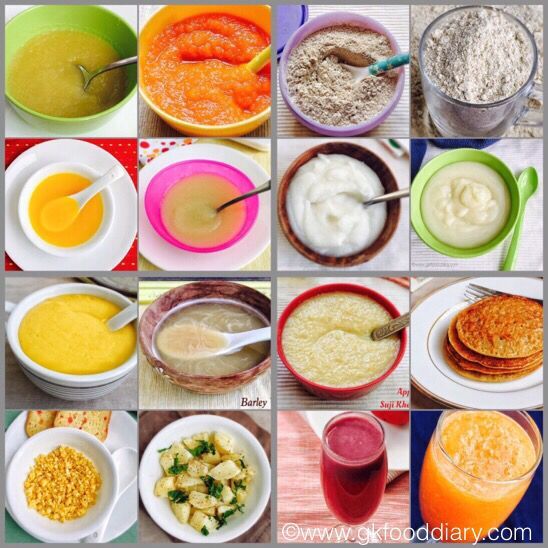
- In a small saucepan, add the frozen puree cubes you want to serve to your baby.
- Over medium-low heat, gently cook the puree until warm, stirring occasionally.
Thawing Tip: Some infants like their puree cold, warm, or really warm, and some will eat it no matter the temperature. You will get to know your baby’s personal preferences as the two of you bond over food.
Feeding Tips
- Make sure baby is showing readiness signs for eating – good control of their head and trunk, sitting with minimal assistance, bringing hands or toys to their mouth, and appearing interested in your food when you’re eating.
- Follow your baby’s lead – when feeding purees from a spoon, sometimes there’s a tendency to keep offering bites past the point of your baby being full. Always follow your baby’s cues for when they are done eating. Turning away from the spoon, closing her mouth, or pushing food away are all signs that your baby is finished with the meal.

- Throwing spoons – is a common phase that all babies go through at one point or another. One of the best ways to handle spoon throwing is to ignore it and keep feeding your baby as usual (with an extra spoon you already have at the table). If your baby ends up also throwing back up spoons #2 AND #3, simply encourage your baby to eat with their hands until they appear to be finished with the meal.
Top Rated Baby Food Purees
Pea Baby Puree (Stage One)
4.91 stars (83 ratings)
A delicious way to introduce peas to baby. Mild peas paired with a fresh hint of mint – a mouth-watering combo!
Get the recipe
Apples Baby Food Puree
4.75 stars (56 ratings)
This Apple Baby Puree recipe is a wonderful first food for baby! A delicious nutrient-dense puree that baby will go gaga over!
Get the recipe
The Best Sweet Potato Baby Food
5 stars (55 ratings)
This Homemade Sweet Potato with Curry Baby Food Puree is a fun and exotic first puree for baby! Great for 4+ months and is completely freezer-friendly!
Get the recipe
Broccoli Baby Food
4. 80 stars (68 ratings)
80 stars (68 ratings)
This Broccoli Baby Food with olive oil recipe is a great way to introduce healthy green vegetables into your baby's diet. A delicious puree full of essential vitamins and healthy fats for growing baby
Get the recipe
Oatmeal for Babies (Stage One)
5 stars (40 ratings)
This Oatmeal Recipe for Baby is made with simple nutrient-dense ingredients in less than 10 minutes, and it's perfect for baby's first bite or added into their favorite fruit or veggie puree. Great for 4+ months and up.
Get the recipe
Avocado for Baby – Puree & BLW
5 stars (16 ratings)
Avocados are a superfood and great first food for babies 6 months and up. Serve them pureed, smashed, or as a finger food for baby-led weaning.
Get the recipe
WeeSprout Baby Food Freezer Tray
My all-time favorite freezer tray! Individual servings pop out easily.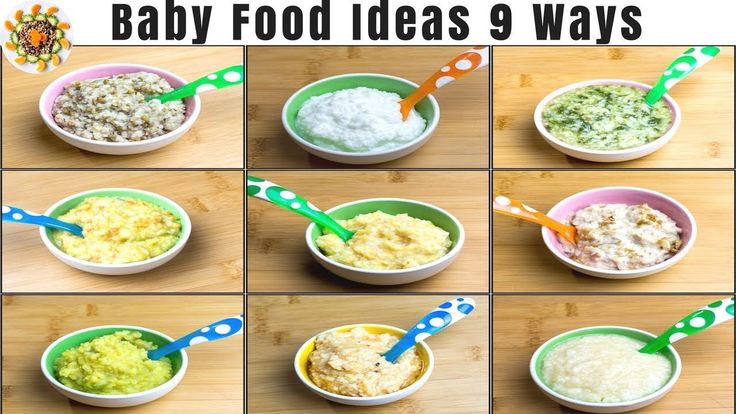 The hard plastic lid snaps on with ease and allows for convenient stacking of freezer trays. Dishwasher safe!
The hard plastic lid snaps on with ease and allows for convenient stacking of freezer trays. Dishwasher safe!
View Product
Butternut Squash Baby Food
5 stars (30 ratings)
This homemade Roasted Butternut Squash Baby Food Puree not only contains calcium, folate, vitamins A and C and fiber but it is also a deliciously smooth way to introduce butternut squash to your baby!
Get the recipe
Green Bean Baby Food
5 stars (34 ratings)
Green beans are steamed until just tender, this puree has a mild taste for baby's palette.
Get the recipe
Creamy Mango-licious Baby Food Puree
4.85 stars (26 ratings)
This 5-minute Mango Baby Food Puree is a great way to introduce baby to the magical taste of one of the world's healthiest fruits – MANGOS!
Get the recipe
Pear Baby Puree (Stage One)
5 stars (19 ratings)
This smooth and creamy homemade Pear Baby Puree is a wonderful first puree for baby – easy on the taste buds and great for their growing bodies!
Get the recipe
Peach Baby Puree (Stage One)
5 stars (15 ratings)
Smooth and creamy, this homemade Peach Baby Puree delivers big on taste with naturally sweetened peaches and flecks of vanilla bean.
Get the recipe
Basic Chicken Baby Food
4.41 stars (195 ratings)
This homemade Basic Chicken Baby Food is a great puree to add to any of your baby’s favorite fruit or veggie purees. Great for extra protein and flavor!
Get the recipe
Homemade Baby Rice Cereal
4.88 stars (48 ratings)
Using only 1-ingredient, this Homemade Baby Rice Cereal is a simple and easy recipe to make baby!
Get the recipe
Red Pepper Baby Puree
4.88 stars (33 ratings)
This Red Pepper Baby Puree recipe is a smooth, creamy and naturally sweet puree that is loaded with vitamin A, B6 and C. Great for 4+ months and older (or stage 1 puree).
Get the recipe
More Baby Fooe Purees
- Strawberry Baby Puree
- Blueberry Baby Puree
- Pumpkin Baby Puree
- Rasberry Baby Food
- Banana Puree
- Homemade Quinoa Baby Cereal
Pea Baby Food Puree
- 2 cups peas, fresh or frozen
- 1 medium zucchini, roughly chopped (optional)
- 4 mint leaves, roughly chopped (optional)
Sweet Potato Baby Food Puree
- 2 large sweet potatoes
- 1/4 tsp mild curry powder (optional)
- 1/4-1 cup liquid, (water, fresh breast milk, formula or sodium-free chicken stock) for pureeing
Roasted Banana Puree
- 4 bananas, cut lengthwise
- 1/8 tsp fresh rosemary, finely chopped (optional)
Carrot Baby Food Puree
- 2 pounds carrots, trimmed, peeled and roughly chopped
- 1/4 tsp nutmeg (optional)
- 1/2-1 cup liquid, (water, reserved water, fresh breast milk, formula or low-sodium stock) for pureeing
Apples Baby Food Puree
- 6 apples, peeled, cored and chopped
- 1/2 cup water
- 1/4 tsp cinnamon (optional)
Broccoli Baby Food Puree
- 2 cups broccoli, chopped into small florets
- 1 small white potato, apple or pear, peeled and roughly chopped, roughly 1/2 cup (optional)
- 1 tbsp good quality olive oil (optional)
Butternut Squash Baby Puree
- 1 butternut squash
- 1 tsp fresh thyme, roughly chopped (optional)
- 1-2 tsp olive oil (optional)
- 1/2-1 cup liquid (water, fresh breast milk, formula, low or no-sodium stock or bone broth), for pureeing
Green Bean Baby Food Puree
- 1 pound green beans, fresh or frozen, trimmed
- 1 big pinch fresh basil, cilantro or parsley, finely chopped (optional)
Creamy Mango-licious Baby Food Puree
- 2 cups fresh or frozen mango, deseed, peeled and roughly chopped.
 If using frozen mangos, thaw first
If using frozen mangos, thaw first - 1 medium banana (optional)
- 1 pinch nutmeg (optional)
Pear Baby Food Puree
- 6 pears, peeled and roughly chopped
- 1/8 tsp cardamom or cinnamon (optional)
- 1/4 cup water
Peach Baby Puree
- 3 fresh peaches or 12oz frozen peaches, do not thaw frozen peaches – use frozen
- 1/4 cup water
- 1/2 tsp vanilla bean pod (optional)
- 1 pinch pinch nutmeg (optional)
Basic Chicken Baby Puree
- 1 8-ounce boneless skinless chicken breast or thighs, cubed
- 1 cups chicken or veggie stock, low-sodium or sodium-free
- 1 tsp dried parsley (optional)
Homemade Baby Rice Cereal
- 1 cup brown rice, I prefer organic short grain
- 2 cups water for cooking
- 1-2 cups of liquid for blending, (water, fresh breastmilk or formula)
Red Pepper Baby Puree
- 2 red bell peppers, deseeded and roughly chopped
- 1/2 cup white potato, apple or pear, peeled and roughly chopped
Oatmeal for Babies
- 2 cup water
- 1 cup old fashioned oats
- 1/2 tsp chia seeds (optional)
- 1/2 tsp hemp seeds (optional)
Avocado for Baby
- 1/4 avocado
- 1 tsp breast milk, formula or water
Pea Baby Food Puree
In a medium saucepan, bring 2″ of water to a boil over medium heat.
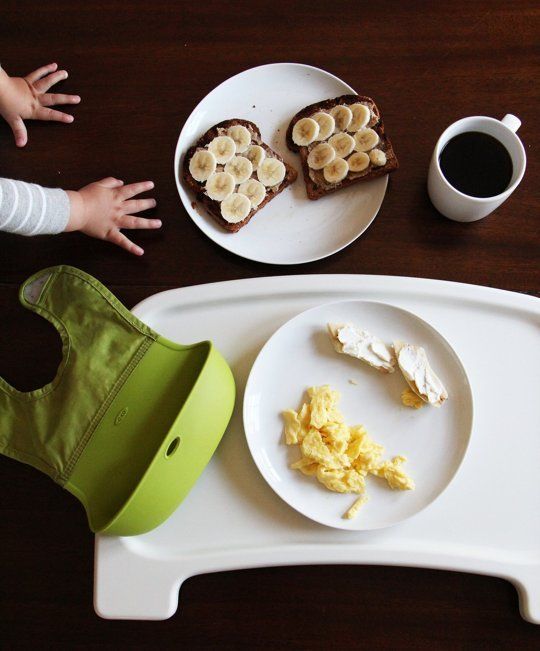 Place the zucchini in a steamer basket, and place over boiling water. Cover and steam for 5 minutes.
Place the zucchini in a steamer basket, and place over boiling water. Cover and steam for 5 minutes.Add in the peas, and steam for an additional 3-5 minutes. Reserve steamer water. Let cool slightly.
Add the zucchini, peas and mint leaves to a blender or food processor and puree for 1 minute or until you have achieved the desired texture. If the puree is too thick, add in 1/4 cup of the reserved steamer water until you have the right consistency.
Note on Zucchini: while this is a 2 vegetable starter puree, zucchini allergies are very low, so I added it to this recipe to give the peas a mild taste and smoother texture. You can completely leave them out if you prefer. Just steam the peas as directed.
Sweet Potato Baby Food Puree
Heat oven to 400°. Line baking sheet with tin foil, parchment paper or a silicone mat.
Wash and dry the sweet potatoes.
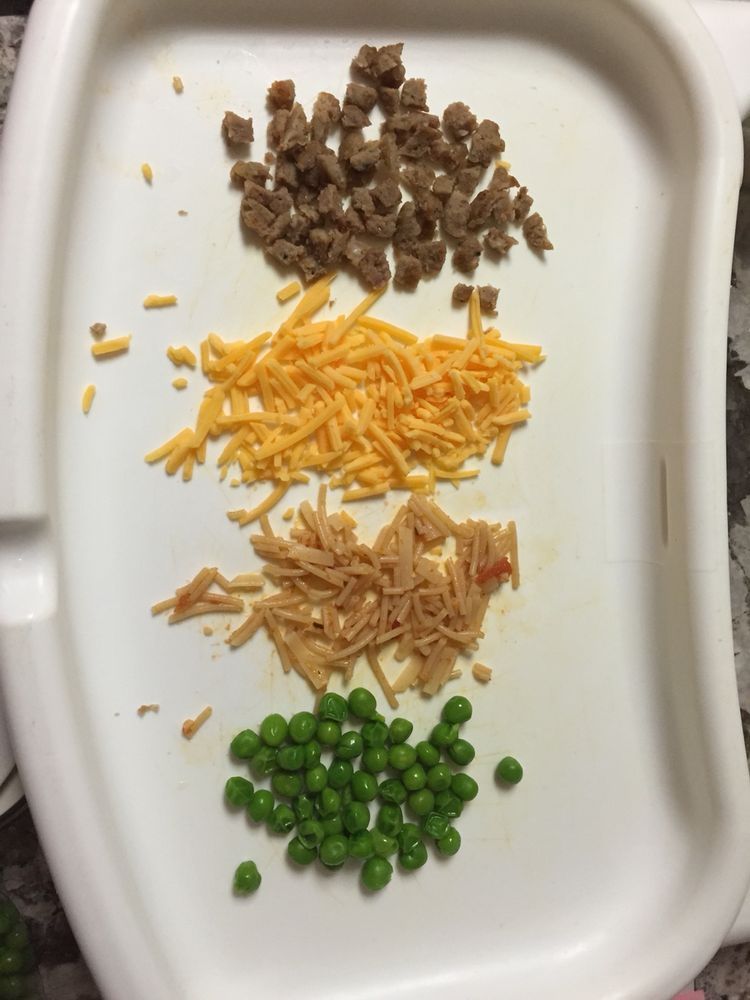 Prick with a fork in several places and then place the sweet potatoes on the baking sheet. Bake for 45 minutes – 1 hour or until a fork can easily prick the sweet potato. Let sit until cool to touch.
Prick with a fork in several places and then place the sweet potatoes on the baking sheet. Bake for 45 minutes – 1 hour or until a fork can easily prick the sweet potato. Let sit until cool to touch.Make a cut into the skin of the potato lengthwise and peel away the skin of the potato. Scoop out the sweet potato meat and place into a blender or food processor, adding in the mild curry powder and water.
Puree on high for 1-2 minutes or until smooth, adding in additional liquid in 1/4 cup increments if needed. I had to add in 1 cup of water to the puree pictured. Serve or freeze for a later meal.
Additional Spices: Feel free to use the following spices instead of the curry – 1/2 tsp of cumin, 1/4 tsp of nutmeg, 1/2 tsp of cloves, 1 fresh garlic clove, 1/2 tsp of chopped fresh thyme, 3-4 basil leaves, 1/2 tsp chopped rosemary or even a big pinch of fresh ginger or 1/2 tsp ginger powder.
 Or you can leave out the spices altogether.
Or you can leave out the spices altogether.
Roasted Banana Baby Puree
Heat oven to 325 degrees F. Line baking sheet with parchment paper.
Place bananas on a baking sheet and roast for 10-12 minutes or until golden brown. Let cool slightly.
Place bananas and rosemary into a blender or food processor and puree for 1-2 minutes or until completely smooth. You may need to add additional water, so start by adding in 1/4 cup increments until you get the desired consistency.
Additional Spices: This recipe is also great with 1 tsp cinnamon, 1/2 tsp cloves, 1/2 tsp nutmeg, or for a fun twist, 1/2 tsp mild curry.
Note on Bananas: while any ripeness of bananas will work, I have found that the bananas that are ripe to very ripe tend to work best in this recipe.
Carrot Baby Food Puree
In a medium saucepan, bring 2″ of water to a boil over medium heat.

Place the carrots into a steamer basket, cover and cook for 9-11 minutes or until tender. Reserve steamer water. Let cool slightly.
Place the carrots, nutmeg and 1/2 cup of liquid into a blender or food processor and puree for 1-2 minutes on high, adding 1/4 cup liquid at a time until you achieve the desired consistency. Serve and enjoy, or freeze for later.
Notes on Nutmeg: adding in spices to babies first purees are completely optional, but totally safe. Nutmeg rounds out the acidic taste carrots sometimes have and make this puree taste grounded and full-bodied.
Additional Spices: Feel free to substitute 1/2 tsp ginger powder or 1/4 fresh ginger, 1/2 tsp mild curry powder, 1/4 tsp cloves, 1/2 tsp finely minced fresh chives or 1/2 garlic clove instead of the nutmeg.
Apples Baby Food Puree
In a medium saucepan, place the apples, water and cinnamon.
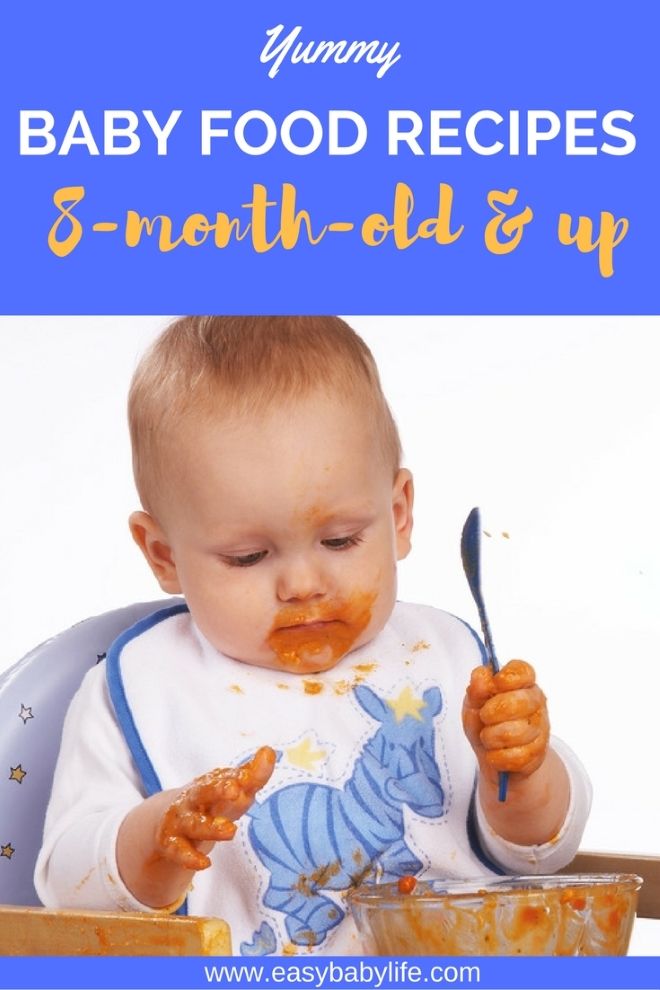 Cover and heat on medium-low for 15-20 minutes or until apples are tender. Let cool slightly.
Cover and heat on medium-low for 15-20 minutes or until apples are tender. Let cool slightly.Transfer all of the ingredients into a blender or food processor and blend for 1-2 minutes or until completely smooth. For a chunky puree, quickly pulse the ingredients 10-15 times or until you receive your desired consistency. Serve or freeze for later.
Additional Spices: Feel free to sub in these spices instead of the cinnamon for this recipe – 1/8 tsp of cloves, 1/8 tsp of nutmeg, 1-2 leaves of fresh mint, 1-2 leaves of fresh basil, a pinch of fresh or 1/4 tsp of ginger powder or even 1/4 of coriander for a fun twist.
Apples: you can use any sweet apple in this recipe – Gala, Honeycrisp, Fuji, McIntosh, etc.
Broccoli Baby Food Puree
In a medium saucepan, bring 2 inches of water to a boil over medium heat. Place the broccoli and potato (or apple/pear) into a steamer basket and place over boiling water, cover and steam for 10-12 minutes or until the broccoli and potato are tender.
 Reserve water from the steamer. Let cool slightly.
Reserve water from the steamer. Let cool slightly.Add the broccoli, potato and olive oil into a blender or food processor and puree until smooth, adding the reserved water from the steamer basket in 1/4 cup increments if needed.
Adding In Spices: Feel free to add in 1 tsp of chopped chives, 2-3 mint leaves, 1 tsp of chopped cilantro, 1/2 tsp cumin or a squeeze of fresh lemon juice.
Butternut Squash Baby Puree
Heat oven to 450 degrees F. Line baking sheet with a silicone mat, tin foil or parchment paper.
Cut butternut squash in half, deseed and place flesh side up, skin side down. Optional – Feel free to drizzle the squash with 1-2 teaspoons of olive oil for some added healthy fat.
Bake for 45 minutes or until you can easily prick the squash with a fork. Let cool until you can handle the squash with your hands.
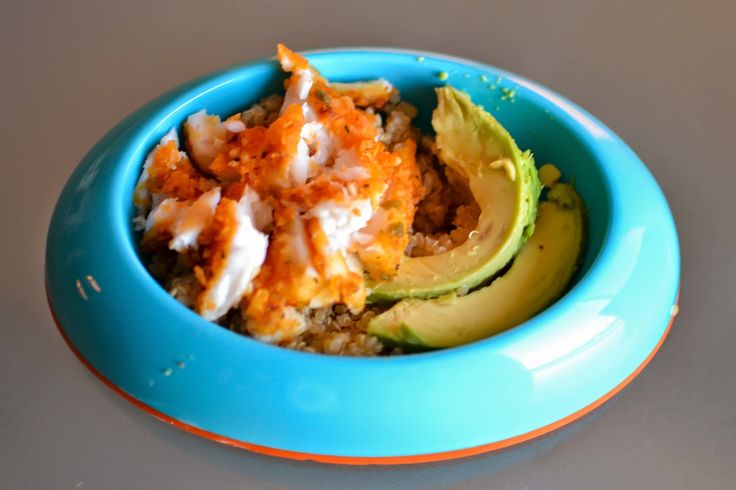
Scrape off the skin and discard. Place the butternut squash into a blender or food processor. Add thyme and puree for 1-2 minutes, adding water in 1/4 cup increments until you have your desired consistency. I had to add 3/4 cup of water to my puree shown below.
Additional Spices: Feel free to sub the thyme for 4 basil leaves, 1 tsp chopped rosemary, 1 tsp ginger powder, or 1 big pinch of fresh ginger, 1/2 teaspoon nutmeg, or even 1/2 tsp of coriander.
Green Bean Baby Food Puree
Fill a medium saucepan with 2” of water and bring to boil over medium heat. Place the green beans (fresh or frozen) into a steamer basket over the boiling water, cover, and cook for 10 minutes or until tender. Let cool slightly. Reserve steamer water.
Transfer the green beans and herb to a blender or food processor and puree for 1-2 minutes or until smooth, adding reserved steamer water in 1/4 cup increments if needed until you reach your desired consistency.

Adding Spices: you can add a big pinch of roughly chopped basil, cilantro, mint, parsley, or chives to this puree before blending.
Creamy Mango-licious Baby Food Puree
Place the mango, banana and nutmeg (if using) into a blender or food processor. Puree for 1 minute or until completely smooth. If your mango is not ripe enough, you might need to add in up to 1/4 cup of water while blending to get the right consistency. Serve or freeze for later.
Mango Tip: I usually find that organic frozen mangos are easier and cheaper to find than fresh organic mangos, but if mangos are in season when you are making this recipe, by all means, you can use fresh over frozen. For fresh mangos, simply peel and chop.
Pear Baby Food Puree
In a medium saucepan, place the pears, cardamon and water, cover and heat on medium-low heat for 10-15 minutes, or until tender.
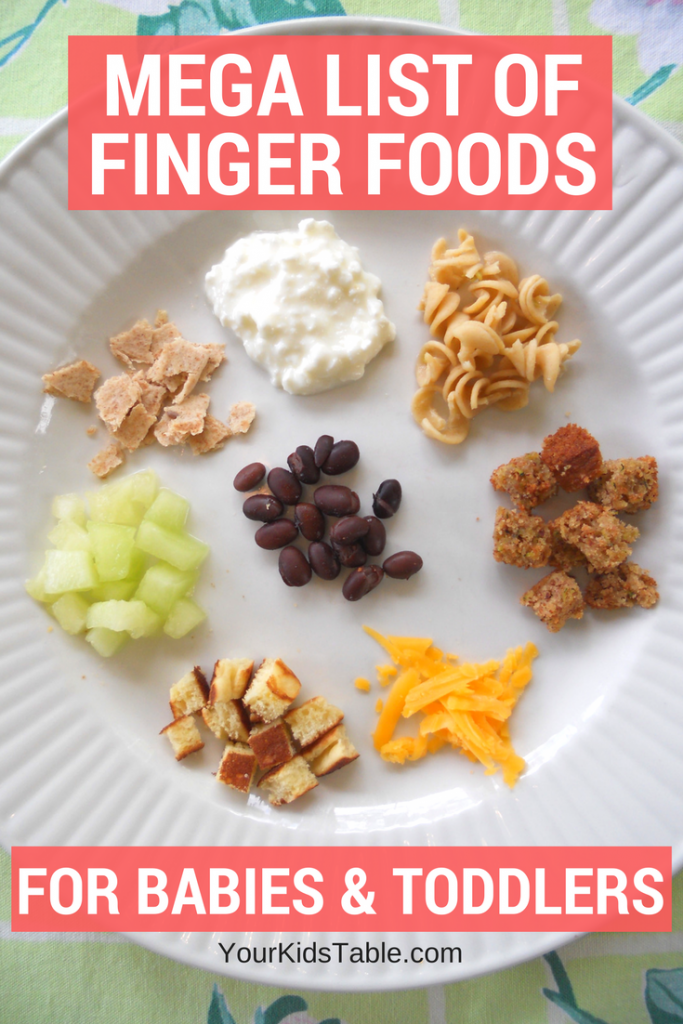 Let cool slightly.
Let cool slightly.Using a slotted spoon, scoop the pears out of the saucepan, leaving water behind, and into a blender or food processor. Blend for 1-2 minutes until you have your desired consistency. If your pear puree is too thick, add the leftover cooking water in 1/4 cup increments.
Peach Baby Puree
If using fresh peaches, peel, pit and slice the peaches. If using the fresh vanilla bean pod, cut in half and then slice open lengthwise. Take the back of your knife or spoon and scrape out all of the vanilla bean, reserve.
In a medium saucepan, add the peaches and water, cook over medium-low heat for 5 minutes (fresh peaches) – 10 minutes (frozen peaches). Right before the peaches are done cooking, add in the vanilla and nutmeg (or any other spices you prefer) and stir until incorporated—Cook for 1 more minute.
Using a slotted spoon, transfer the peaches to a blender or food processor, leaving all excess water in the saucepan.
 You do not want to add any additional liquids, or the puree might be too thin. Starting on low and increasing to high speed, puree the peaches until smooth and creamy. Serve to baby or freeze for later.
You do not want to add any additional liquids, or the puree might be too thin. Starting on low and increasing to high speed, puree the peaches until smooth and creamy. Serve to baby or freeze for later.
Basic Chicken Baby Puree
In a medium saucepan, bring the cubed chicken, broth, and parsley to a boil over medium heat. Turn the heat down to low and simmer, covered, for 15 minutes or until chicken is just cooked through. Let cool slightly.
Using a slotted spoon, transfer the chicken to a blender or food processor, leaving the broth in the saucepan. Reserve the broth.
Starting on low and working your way up to high-speed, puree the chicken until you reach your desired consistency, adding in broth in 1/4 cup increments if needed. I had to add in just 1/4 cup of broth to get the consistency seen in this photo.
Extra Healthy Fat: For some extra healthy fat, this puree is also wonderful, with a teaspoon of grass-fed butter (salt-free) added to the blender right before pureeing.
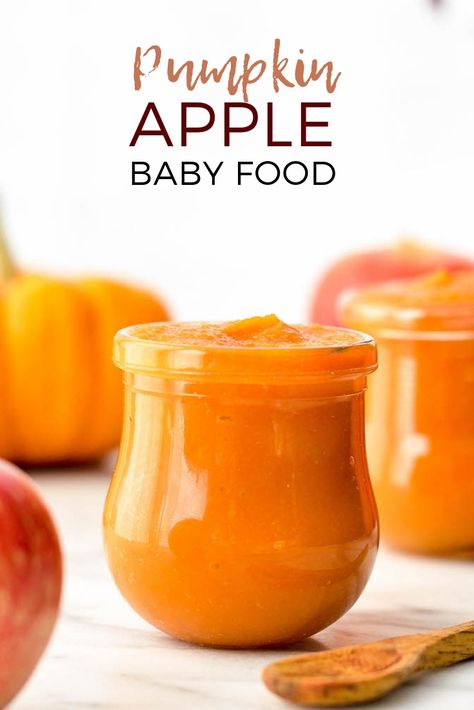
Homemade Baby Rice Cereal
IMPORTANT STEP: Place the rice in a fine-mesh colander and rinse with water until the water runs clear.
Transfer the rice to a medium saucepan and add 2 cups of water. Bring to a boil over high heat, then reduce heat to low, cover with a lid and simmer for 35-45 minutes or until the rice is tender and the water is evaporated. Each batch of rice cooks a little differently, so taste at 35 minutes to see if the rice is tender. Remove the saucepan from the heat and let rest for 10 minutes, covered. If using fresh breast milk or formula for blending, I would remove the lid and let the rice cool for 15 minutes.
Place the rice into a blender or food processor and add 1/2 cup of liquid of choice. Blend for 1-2 minutes on medium-high speed until completely smooth and creamy, adding in the additional liquid in 1/4 cup increments, if needed, until you have your desired consistency.
Red Pepper Baby Puree
In a medium saucepan, bring 2″ of water to a boil.

If using a potato: place it in a steamer basket and steam for 10 minutes before adding peppers, and cooking for another 5-7 minutes.
If using pear or apple: add in the red peppers and apple or pear and steam for 5-7 minutes or until tender. Reserve steamer water. Let cool slightly.
Add in all of the ingredients into a blender or food processor and puree for 1 minute or until completely smooth, adding in a tablespoon of water at a time if needed.
Oatmeal for Babies
In a medium saucepan, bring 2 cups of water to a boil. Add in 1 cup of old-fashioned oats along with the chia seeds, hemp seeds and any spices you are using. Turn down the heat to medium-low and cook the oats for 5 minutes, stirring occasionally, or until all of the water is gone and the oats are soft. Let cool slightly.
Transfer the oats to a blender or food processor and puree for 1-2 minutes, adding water in 1/4 cup increments if needed, until completely smooth.
 I had to add 1/2 cup of water to my oatmeal. You will want the oat cereal to be on the thinner side, so it doesn't become sticky. The oats will continue to absorb liquid as they cool, so you can add more water, fresh breast milk, or formula as needed. Serve to baby or freeze for later.
I had to add 1/2 cup of water to my oatmeal. You will want the oat cereal to be on the thinner side, so it doesn't become sticky. The oats will continue to absorb liquid as they cool, so you can add more water, fresh breast milk, or formula as needed. Serve to baby or freeze for later. Type of Oats: This recipe is for old-fashioned oats: for steel-cut or instant oats, read the full post.
Adding Spices: you can add a big pinch of cinnamon or pumpkin pie spice mix or a smaller pinch of nutmeg or cloves to these oats before blending.
Chia and Hemp Seeds: are added for a nutritional boost, but you can add or omit them if you prefer. You can get both of these at any health food store or online here (chia/hemp).
Avocado for Baby
Age: 4-6 months and up
Yield: roughly 15-25 ounces, depending on the recipe
Freezer Tray
Bumkins Baby Bowl
Blender
Saucepan
Did you make this recipe?
Tag @babyfoode on Instagram and hashtag it #babyfoode!
Pin Recipe Email a Friend
Recipes for babies under one year old - what to cook for babies
Chicken puree for babies 5.0
When you have a small child, you simply cannot do without a blender or mixer in the kitchen. Only with them will you get the right texture of puree for the first feeding. And the recipe is simple. ...more
3.8
If you prefer to cook milk porridge, then you should pay attention to the recipe for barley porridge with milk, which has time to melt and boil before it is served to the table - very tasty.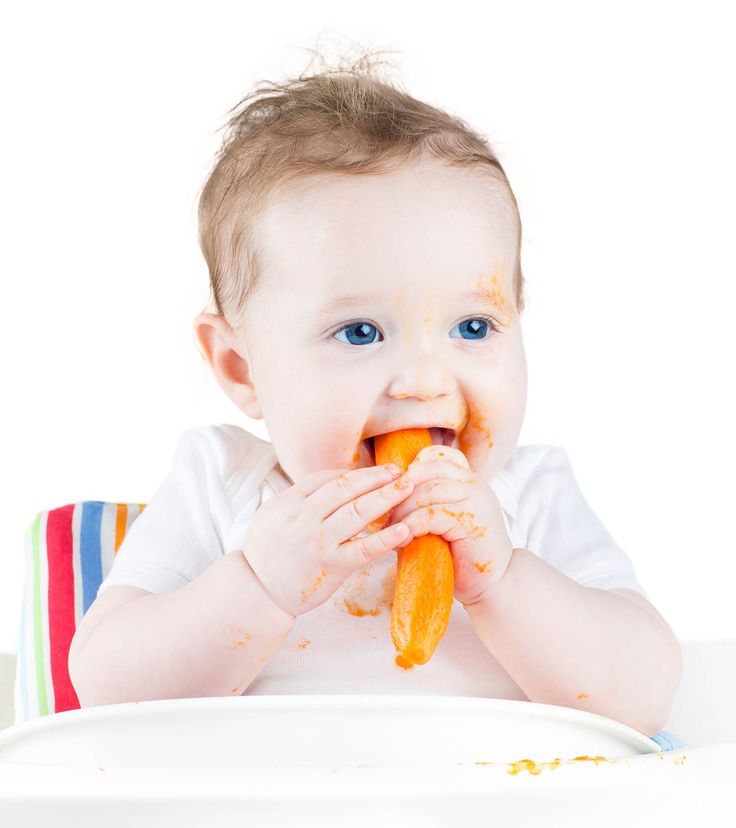 ...more 5.0
...more 5.0
Starting from 4-6 months, pediatricians recommend that mothers introduce vegetable and fruit purees into the baby's diet. Homemade pumpkin puree is ideal for a first acquaintance. ...more
Added by: Oksana Ch. 12/02/2018
Applesauce for babies for the winter 4.7
Making applesauce for babies for the winter is not at all difficult as it might seem at first glance. All we need is delicious and fragrant homemade apples. ...more
Added by: Oksana Ch. 27.08.2019
4.6
Here is a simple recipe for making semolina porridge. Cook it for breakfast. It is very useful not only for the little ones, but also for the big ones. The best breakfast is porridge, athletes say. Be healthy! ...more
Added by: Povarru 03/28/2014
Pear puree 4.1
Pear puree is one of the first foods to be introduced to a baby. This is not surprising, because the pear is very useful - it contains a lot of vitamins and nutrients! I tell you how to make pear puree for babies.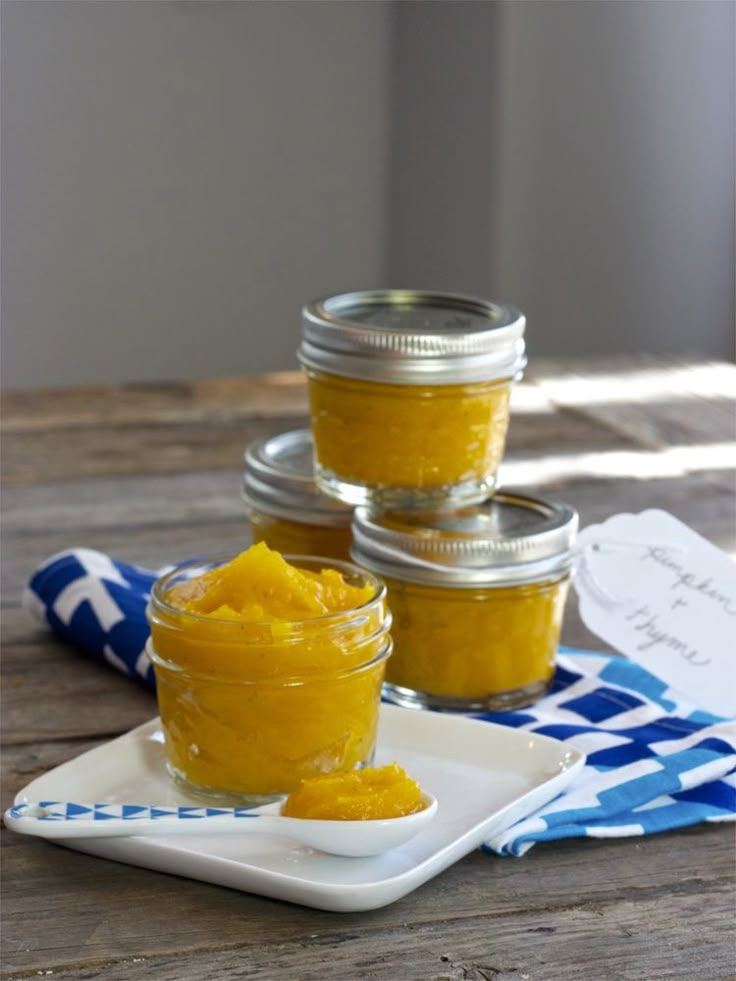 ...more
...more
Added by: Kurzyupa 12/24/2013
Delicious semolina porridge with milk 5.0
For little kids (and adults who love delicious dairy breakfasts) semolina is a must-have dish in the list of morning cereals! I recommend a note in your cookbook recipe for semolina porridge! ...more
Added by: Marina Shcherbakova 07/16/2016
3.0
Tasty and hearty corn porridge for the first feeding is easy to prepare at home not from a mixture in a pack, but using finely ground corn grits and milk of the required grade and fat content. ...more
Added by: Prika 09/03/2019
4.2
Banana puree is most often prepared for babies, but because it is very tasty, it can also be served as a dessert. Below is a simple banana puree recipe. ...more
Added by: Mengrel12 08/19/2014
Corn porridge with milk 4.0
Having tried this wonderful porridge for the first time, I immediately fell in love with its amazing, incomparable taste, so now my day almost always starts with this healthy dish. ...more
...more
Pumpkin semolina 4.0
Healthy pumpkin with semolina is a wonderful breakfast for both adults and children. I recommend the recipe for making semolina porridge with pumpkin for all occasions! ...more
Added by: Marina Shcherbakova 10/20/2015
4.2
Homemade cottage cheese for babies is an excellent complementary food that starts from 7 months (for some children - from 4). You can prepare such a dessert quickly with the help of milk and kefir. ...more
Added by: Yulia Malchenko 11/27/2015
Wheat porridge with milk 3.6
An ideal breakfast is something that is both healthy and fast, because no one wants to sweat for a long time in the morning, especially if you are in a hurry to work. Wheat porridge with milk - just what you need! Try it! ...more
Added by: Alexey Marchuk 06/15/2016
4.6
Diversify your kids' menu, and yours too, by preparing delicious and healthy milk corn porridge. Porridge can be made sweet, add fruits and nuts - very satisfying and healthy, I recommend it! ...more
Porridge can be made sweet, add fruits and nuts - very satisfying and healthy, I recommend it! ...more
Added by: Marina Shcherbakova 08/15/2016
5.0
When a child reaches the age of 6-7 months, new foods should be added to the diet. One of the most popular dishes for children is soup. I'll tell you how to cook children's soup. ...more
Added by: Alla 12/14/2018
Baby purees 5.0
One of the best first foods for babies is puree. But many mothers are lazy or do not have time, and buy ready-made jars with a dish. Although homemade options are much more useful. Try it for sure. ...more
4.5
Carrot puree is an excellent side dish for meat or fish dishes, as well as a dish suitable for feeding small children. It turns out very tasty. ...more
Added by: Roksolana 04/25/2013
5.0
Rice is a product that is well absorbed by the child's body. Therefore, it is included in the diet from a very young age.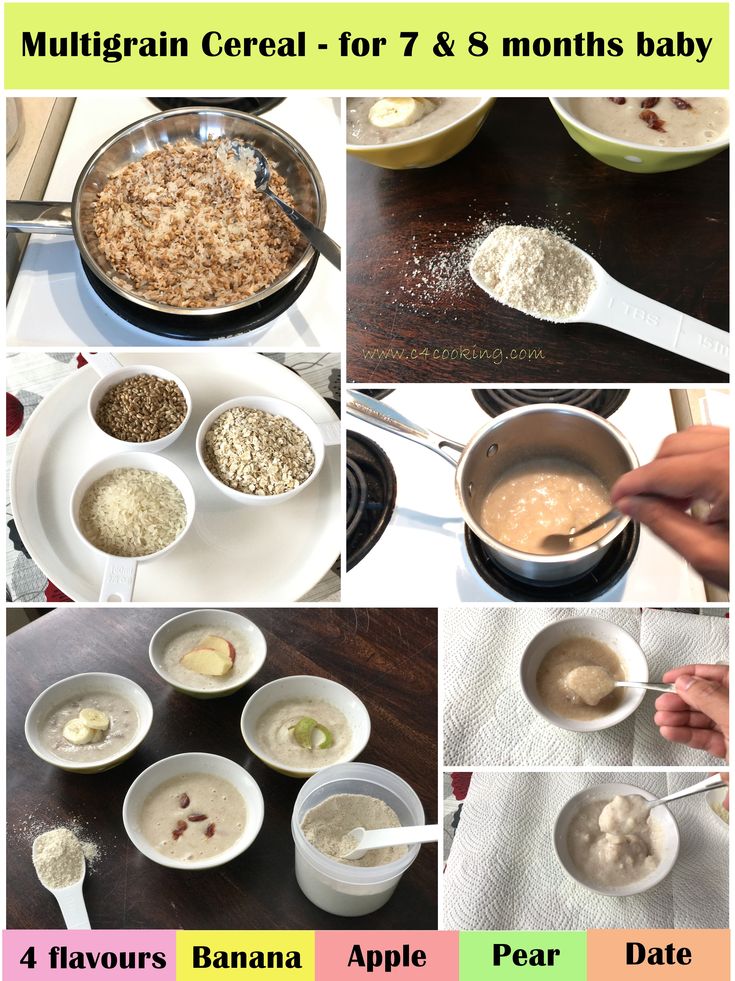 Today we are preparing rice porridge for babies. ...more
Today we are preparing rice porridge for babies. ...more
Added by: Zoya Shunina 08/31/2019
Zucchini puree for babies 4.7
There is a special diet for the little ones. Therefore, I want to offer you one recipe on how to make zucchini puree for babies. Prepare only healthy and fresh food for your baby! ...more
Added by: Mengrel12 09/22/2014
3.0
Lentils are very good for health, and therefore dishes from them should be included in the menu of supporters of a healthy diet. The following will describe how to prepare lentil puree. ...more
Broccoli puree for babies 5.0
For some reason, children really like this puree and that's a fact! Of course, you can buy canned puree in the store, but here the question arises, what is more beneficial for the child? The answer is obvious, the matter is small! ...more
Added by: Alexey Marchuk 07/28/2014
Fruit puree in a slow cooker 5.0
Multi-cooker fruit puree can be prepared from any fruit at home. The most common recipe is apple puree, which can be prepared with any fruit you like. ...more
The most common recipe is apple puree, which can be prepared with any fruit you like. ...more
Added by: Yulia Malchenko 06.11.2014
4.2
Buckwheat porridge is rich in useful minerals and vitamins. Today I want to share a recipe on how to cook buckwheat porridge for the first feeding. Take note of the recipe! ...more 4.6
If you like healthy and tasty breakfasts/snacks, I recommend making delicious pumpkin porridge with rice and milk. The porridge is thick, rich and very appetizing. Incredible dish! ...more
Added by: Alexey Marchuk 09/20/2015
Rice porridge with pumpkin in a slow cooker 4.6
Very tasty and tender rice porridge with pumpkin. Thanks to the multicooker, it will not burn and will not “run away”! Great breakfast option for the whole family! ...more
Added by: Vika Vasilenko 10/19/2015
2.7
Learn how to make currant and cranberry jelly for a child up to one year old, and provide your child with a storehouse of vitamins.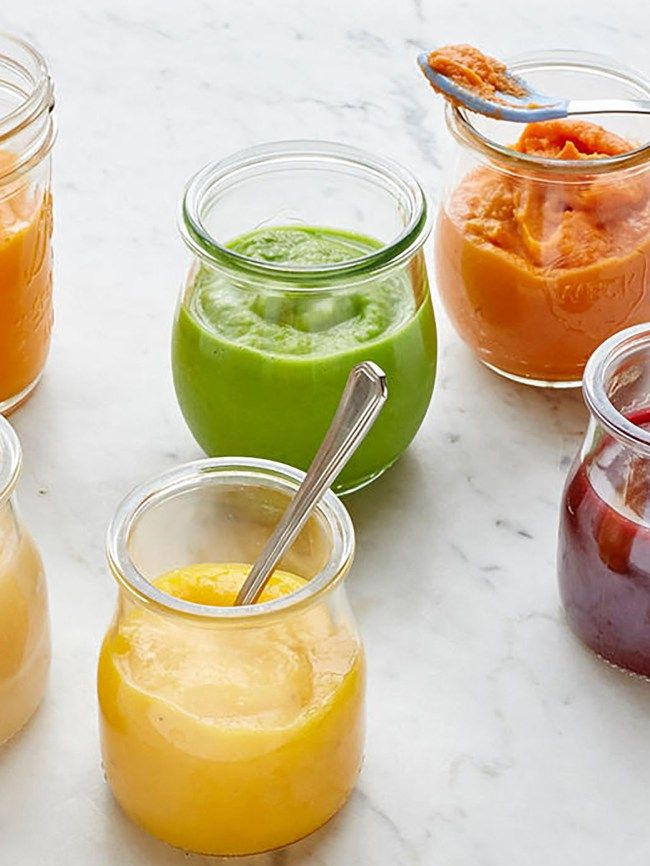 The fragrant delicacy will be to the taste to the kid. Yes, and you will like it too. ...more
The fragrant delicacy will be to the taste to the kid. Yes, and you will like it too. ...more
Added by: NataLi 01/30/2017
3.7
You have a small child, but you don't know what to feed him?) Today I will tell you how to prepare baby food for a child under one year old. We will prepare mashed potatoes based on breast milk. ...more
Added by: Arutyunova Kristina 12/12/2018
Pumpkin for the first feeding 4.8
It takes about 15-20 minutes to prepare a fragrant pumpkin for your baby's first food. Pumpkin puree will turn out tender and juicy, very tasty, velvety in texture. ...more
Added by: AlenaPrika 11/06/2019
5.0
Applesauce is perfect for baby food. Adults will also love it. You can use it both freshly prepared and stock up for future use. ...more 5.0
This prune puree is suitable for babies from 5-6 months. A lot of mashed potatoes are not recommended because of its laxative properties. Also, prune puree can be added to cereals. ...more
...more
Added by: Alexey Marchuk 08/01/2014
Apple puree 4.2
A simple recipe for apple puree ... more
Added by: Elena Sokolova 07/27/2012 3.7
Applesauce is the first meal in a little man's life after breast milk, since apples are one of the healthiest foods for a baby, let's make applesauce. ...more
Added by: Nufica 10/27/2014
Oatmeal jelly 4.1
Recipe for making oatmeal jelly - to your attention. Such jelly is very useful for the human body. Improves material metabolism, increases immunity, helps to strengthen the body. ... more
5.0
There is probably no child in the world who does not like peaches. This wonderful, sweet, juicy fruit always delights both children and their parents. ...more
4.1
Zucchini puree is very tasty and healthy. The recipe also uses potatoes. In general, why not experiment and make potatoes more healthy and tasty?! ...more
Added by: Alisa 08/02/2012
Broccoli puree 5.
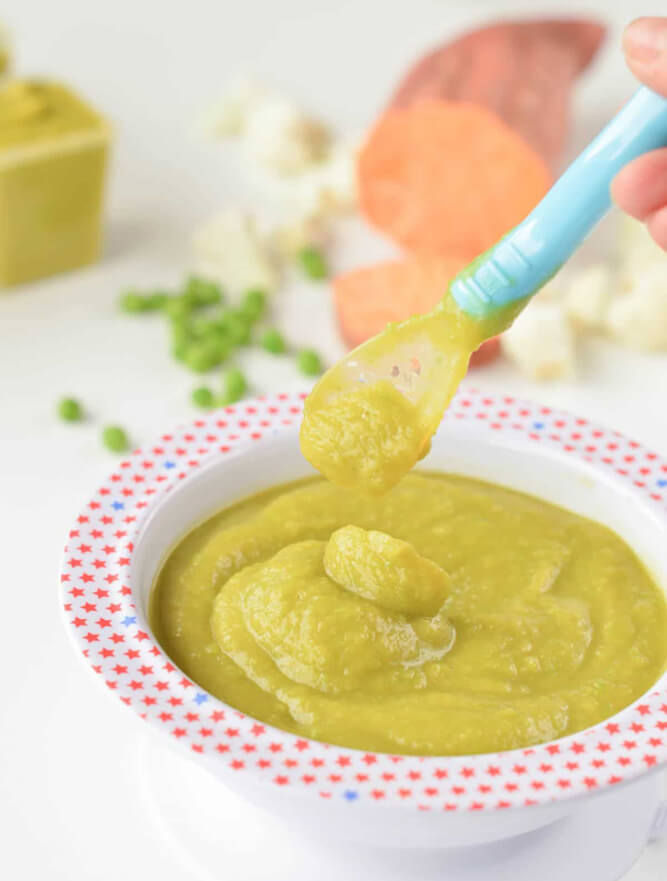 0
0 If you don't mind experimenting, I highly recommend mashed broccoli. Delicious, fast and incredibly healthy - for both adults and children. Try it! ...more
4.0
Is homemade puree worth it? Of course, especially during the first feeding, when the child must eat a full portion of meat in 40 grams, which is still not known whether it is on sale. ...more
Added by: Nufica 11/12/2014
Vegetable puree 5.0
Recently I decided to try a vegetable puree recipe - so to speak, to combine the useful with the pleasant. It turned out to be a decent dietary dish. ...more
5.0
For adults and children, I offer a quick recipe for applesauce. Simple, fast, very tasty - it's worth repeating at home. ...more
Added by: Marina Zolottseva 07/22/2015
Puree in a blender 5.0
It's best to puree with a blender. I figured this out using the example of a recipe for making pea puree in a blender. The blender leaves no chance for lumps and eliminates unnecessary work.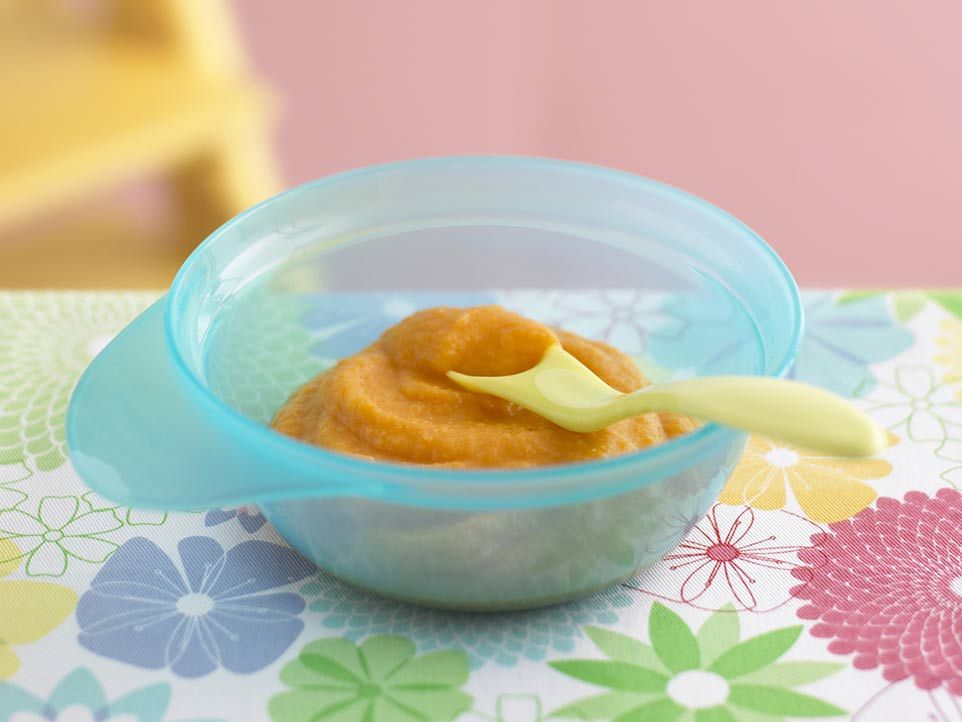 ...more
...more
Added by: Mengrel12 09/14/2014
Pages:
previous next
Recipes in this category : 99
1 2 3
What dishes to include in the children's menu to make it tasty and healthy
In winter, you need to strengthen vulnerable children's immunity by any available means. And for this, you should add as many healthy dishes with a shock portion of vitamins to your daily diet as possible. Mostly it is vegetables in all possible variations. They are good to bake and stew, serve as a side dish, make soups and even delicious desserts based on them. This topic is dedicated to our selection of recipes.
Soup classic
Chicken soup with vegetables is the perfect embodiment of a balanced vitamin meal for a child.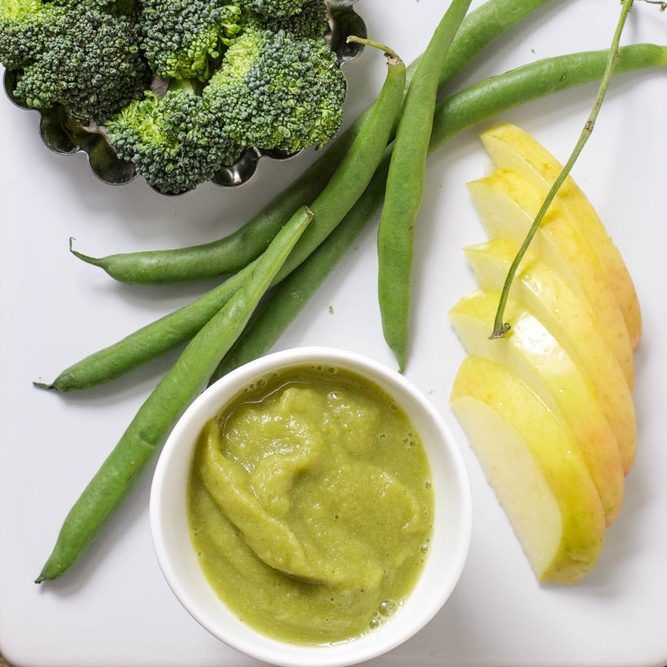 To prepare it, take 2 chicken thighs, pour 3 liters of water and leave to cook over low heat for half an hour. In the meantime, we will make a ruddy frying of the onion, carrot and celery stalk in a saucepan. Just don't overcook the vegetables. As soon as they soften, pour 3 potatoes into cubes and fry for another 5 minutes.
To prepare it, take 2 chicken thighs, pour 3 liters of water and leave to cook over low heat for half an hour. In the meantime, we will make a ruddy frying of the onion, carrot and celery stalk in a saucepan. Just don't overcook the vegetables. As soon as they soften, pour 3 potatoes into cubes and fry for another 5 minutes.
Strain the finished broth and pour the contents of the pot. When the potatoes are completely cooked, lay 50-60 g of egg noodles, salt and pepper the soup to taste, add fresh herbs. Grind the cooled chicken thighs and also pour into the pan. It remains to bring the soup to readiness and let it brew under the lid.
Peppers with a surprise
For the second, offer your child hearty stuffed peppers. Let's start with the filling first. To do this, cook until half cooked 100 g of rice. While it is quietly boiling in a saucepan, we pass the onion into cubes and grated carrots until golden brown. We mix the frying with semi-cooked rice and 300 g of any minced meat, which the child likes best. Add a little salt and dry herbs, knead the mass with your hands. We cut off the caps of 4-5 medium-sized bell peppers, remove the seeds and partitions, fill with minced meat and put upright in a wide pan.
Add a little salt and dry herbs, knead the mass with your hands. We cut off the caps of 4-5 medium-sized bell peppers, remove the seeds and partitions, fill with minced meat and put upright in a wide pan.
Now let's fill it. Stir in 300 ml of hot water, 3 tbsp. l. tomato paste and thick sour cream, put salt and black pepper. Pour the stuffed peppers in a saucepan, bring to a boil and simmer over low heat under a lid for 40–45 minutes. At the end, put the bay leaf and keep the peppers without fire under the lid for a quarter of an hour.
Fish delicacy
In winter, meat in the children's diet is especially important to alternate with seafood. Grilled red fish with sauce is just what you need. We rub the lime zest on a fine grater, squeeze the juice from the fruit and mix everything. Shred 5-6 sprigs of cilantro. We cut the onion into a small cube. Mix citrus juice with zest, herbs and onions. Lubricate 5 portioned pieces of salmon with marinade, leave for 15 minutes.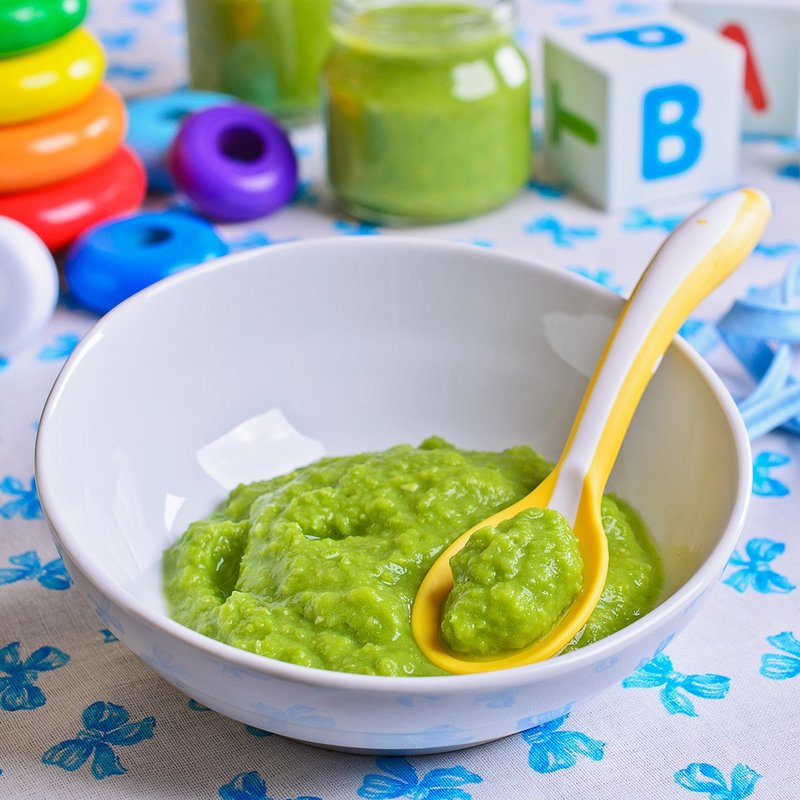
It is better to cook such fish in a grill pan in order to preserve the maximum of nutrients. Fry the salmon on both sides until golden brown stripes appear. Light yogurt sauce is perfect for it. Chop as finely as possible 1 tbsp. l. capers, a clove of garlic, 2-3 sprigs of tarragon. Add 100 g of natural yogurt, juice of half a lemon, season with salt and black pepper. Little gourmets will be pleased, especially if you serve fish on wooden skewers.
Potatoes with vegetable vitamins
Experience shows that children prefer potatoes to many other vegetables. And therefore, you won’t have to persuade them to eat baked potatoes for a long time. We wash 4 oblong tubers in water, wipe dry, grease with oil and bake whole with the skin in the oven at 220 ° C for 45-50 minutes.
Let's make the salad while the root vegetables are ready. Cut 6-8 cherry tomatoes into slices, fresh cucumber into half circles, red onion into half rings. Do not forget to pour boiling water over the onion to remove unpleasant bitterness.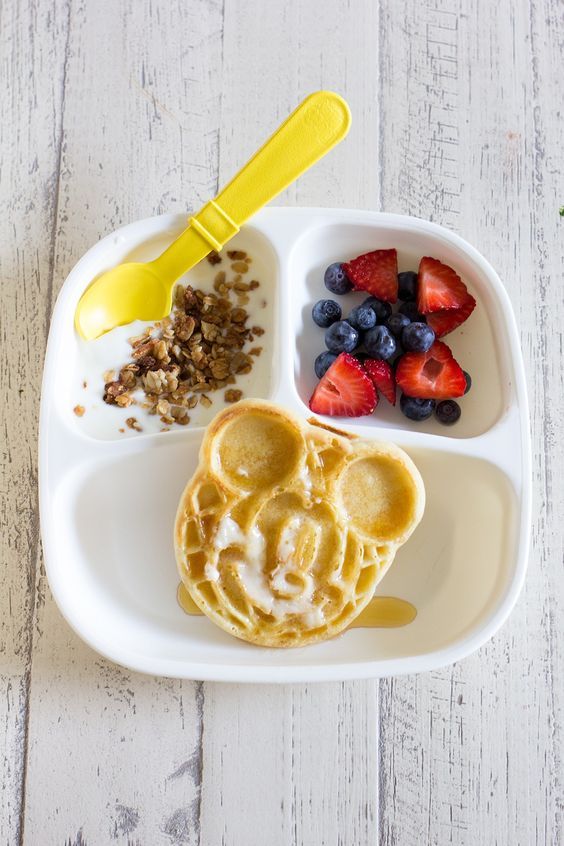 We chop 5-6 sprigs of parsley, mix with vegetables, salt to taste, season with Greek yogurt.
We chop 5-6 sprigs of parsley, mix with vegetables, salt to taste, season with Greek yogurt.
Cool the finished potato tubers, cut off the side part and remove part of the core, we will also mix it into the salad. We fill potato boats with salad and decorate with lettuce leaves.
Curd breakfast
All food for children in the cold season should be healthy, and desserts are no exception. In this regard, the traditional cottage cheese casserole is a win-win option for all occasions.
Whisk the egg vigorously with 1 tbsp. l. sugar and a pinch of salt. Add 300 g of cottage cheese with a fat content of at least 9%, 1 tbsp. l. semolina, 0.5 tsp. baking powder and a pinch of vanilla. We knead the resulting mass well and leave it for 10-15 minutes so that the semolina disperses. If desired, you can put a grated apple, a handful of raisins, banana slices or dried berries here.
Grease ceramic molds with oil, sprinkle with ground breadcrumbs and fill with curd mass. We put them in the oven at 180 ° C for about half an hour. This cottage cheese casserole can be prepared for breakfast. Just let it cool down properly, garnish with mint and serve with sour cream.
We put them in the oven at 180 ° C for about half an hour. This cottage cheese casserole can be prepared for breakfast. Just let it cool down properly, garnish with mint and serve with sour cream.
Cake with an orange mood
Even homemade cakes can be loaded with vitamins and made extremely healthy. Spicy carrot cake is just such a case.
In one container, mix 130 g flour, 1 tsp. baking powder, 70–80 g of sugar, 0.5 tsp each. cinnamon and ground ginger, a pinch of vanilla and nutmeg. In another container, beat 2 eggs with 80 ml of vegetable oil, pour 300 g of grated raw carrots. We combine dry and liquid bases, carefully knead the dough until a homogeneous consistency.
Fill buttered muffin tins with it and bake in the oven at 180°C for 40-45 minutes. When the carrot muffins cool down, they will taste even better. Serve a healthy dessert with whipped cream, and there won't be a crumb left.
Health cocktail
Practically all children drink milk with pleasure.

